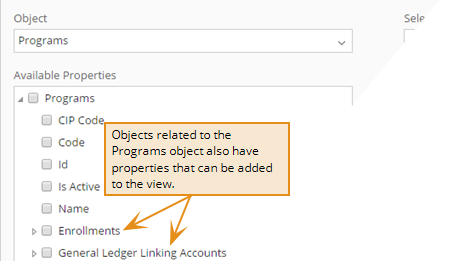Background for Modules, Objects, and Properties in a Query
To add data to a view, you select the modules, objects, and then the properties to include in the query. The table lists the items you use to create the query.
|
Item in List |
Definition |
Example |
Additional Information |
|---|---|---|---|
|
Module |
Corresponds to modules in the legacy interface. |
The Academics module. |
The exception is the Common object. It contains information that appears across modules (such as students, staff, and campuses). |
|
Object |
Corresponds to a category of information in the legacy interface module. |
The Programs object in the Academics module corresponds to:
|
A predictive search option is available. You can type into the search bar to find the Object for use. You have to select the displayed Object from the drop-down. The predictive search option helps you to search without wading through the available lists, saving time and minimizing missing a field on the list that exists. |
|
Property |
Corresponds to a field containing data in the object. When selected, it becomes:
|
The Name property corresponds to the Description field on the Select the Configuration tile > expand Academic Records > select Programs.
|
Not all of the fields are always available. For example, although the Program Group is listed in the Program Code Setup dialog, it is not a property of the Program. It is selectable as a property in the Program Group object instead. A predictive search option is available for the Available Properties list. You can type into the search bar to find the Available Property for use. You use the search icon or select the Enter/Return key to search the particular property. Available Properties also enables you to search for three levels of child properties. The Available Properties search bar:
|
Relationship of an Object to a Property
The relationship of an object to a property in the legacy interface of Anthology Student is displayed when you select the Lists menu > Academic Records > Programs tab and use the Edit button on the tab to access the Program Code Setup dialog.
Objects with Related Data
When an object has related data, you can add the properties of the related object to the view. The illustration shows how related objects are displayed in the Student Web App.

When you create or edit a View in Anthology Student, the system generates an OData query using the selected entity properties/columns. The system limits the number of properties in the OData query to 90. Views will not be displayed and OData queries will not succeed when the limit is exceeded. Opening an existing View that exceeds 90 properties will redirect you back to the grid, where you must select Show Query and edit the properties. If necessary, contact Anthology Support for assistance to modify your custom Views or queries.